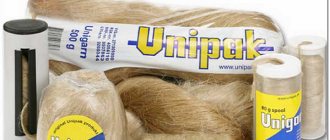Thread for sealing threaded connections
Sealing threaded connections in heating, water and gas supply systems is perhaps the most important task for a plumber or gas equipment installer. Not only the normal functioning of the system, but also the safety of the structure in which it is installed depends on the quality of the work performed. The threaded connection itself is very strong, but it is not capable of holding liquid or gas without special treatment. There are quite a few means for sealing, one of them is a special polymer thread for sealing threaded connections, which will be discussed.
“Moment Germent”, length 15 m.
FUM analogues, which is better: flax, tape or liquid sealants
Square meter (m²) to hectare (ha), metric
Due to the complex installation technology, many inexperienced craftsmen try to choose an alternative option so as not to use fum tape. The following materials are used as seals at pipe joints:
- tow;
- universal thread;
- liquid FUM (anaerobic sealants).
Each type of material has its own characteristics, advantages and disadvantages, as well as recommended areas of application. Therefore, craftsmen are often concerned about what is better to choose: tow or fum tape, liquid sealant or another option.
In addition to fum tape, there are other materials for sealing threaded connections
Should I replace the tape with tow: what is winding and why is it good?
Tow is a natural material based on flax fibers. Designed for sealing steel pipes. It is considered a traditional winding for plumbing systems and, despite the extensive range of more modern materials, is still in high demand among craftsmen.
To determine what is better to take for work: fum tape or flax, it is worth comparing the advantages and disadvantages of these materials. Advantages of sanitary tow:
- the connection is easily adjustable, the fitting can be unscrewed by 45°;
- the material is resistant to mechanical loads;
- high degree of sealing;
- winding over wet or dirty threads is possible;
- due to its ability to absorb moisture, tow swells and blocks minor leaks;
- if necessary, the material can be easily dismantled.
In some cases it is more convenient to use tow
The disadvantages of tow include its susceptibility to rotting. When exposed to moisture, this natural material slowly decomposes.
The scope of application largely depends on what the tow is made from. Plumbing combed flax consists of long, thin fibers that have high strength. They fit tightly and well into the thread. When connecting elements by screwing, the material is not destroyed, so combed flax is best used for gas and pipeline systems.
Torn flax acts as a raw material for the production of combed flax. This material is coarser and its fibers are clogged. It is suitable for sealing threaded connections in water supply systems. Usually tow is preferred by people who do not know how to use fum tape.
In some cases, it is more appropriate to use tape:
- installation of small diameter pipes;
- sealing thin-walled fittings;
- working with plastic pipes.
Thus, to connect a flexible hose to a kitchen faucet, tape is more suitable, and to create a tight connection between a water pipe and a fitting, it is better to use tow.
Tow is as easy to wind as fum tape
Characteristics and scope of application of liquid FUM
Liquid FUM consists of methacrylic anaerobic resin. This product cures slowly to securely lock threaded metal connections. It is not afraid of vibrations, remains flexible and is resistant to temperature changes. Unlike tape, sealant perfectly withstands multidirectional loads and fills voids and small gaps well.
Liquid FUM can fully replace tape and tow in systems with different fillings:
- cold and hot water;
- diesel fuel;
- various oils;
- gas (except oxygen);
- almost any chemical compound.
Externally, anaerobic sealant looks like a blue liquid with a viscous consistency. The density of this product is 1.09 g/cm³. There is a slight odor. General characteristics:
- operating temperature - from -55°C to 180°C;
- shelf life - more than 12 months. (at a temperature not exceeding 28°C);
- withstands pressure up to 50 bar;
- afraid of solvents - trichloroethane, acetone.
The use of anaerobic thread sealant in plumbing work
Primary hardening of the material occurs after 2-3 hours; complete hardening requires from 12 to 24 hours.
Application area
Thread sealing thread (or sealing thread) is a new generation universal polymer sealant used for both metal and plastic pipes for various purposes. It is made of two types of material: polyamide or fluoroplastic.
"SantekhNit", length 50 m.
Polyamide is a low-wrinkle synthetic fiber with an upper temperature limit of 130°C. Thread made from this material has increased wear resistance (10 times more than cotton) and resistance to many aggressive environments. When wound onto a thread, it can withstand a water pressure of 16 bar and a gas pressure of 8 bar.
Sprit sealing thread complete with an additional 50 m skein.
Fluoroplastic is a fluorine-containing polymer with an upper temperature limit of more than 200°C. It is characterized by plasticity, heat resistance and high adhesion. Even more resistant to aggressive environments than polyamide. Polyamide thread, when wound on a thread, can withstand pressure up to 30 bar.
"Tangit Uni-Lock", length 80 m.
At the same time, there is a danger that with a sharp change in temperature and increased vibration, the plumbing thread may become deformed, which will lead to a leak of liquid (gas). For this reason, professional plumbers of the Soviet school often prefer plumbing flax - an old, proven product, if handled skillfully, will never fail.
Winding technique
No special preparation of the thread is required before winding (you don’t even have to remove the rust - the connection will not be damaged). The only condition is that the thread must be intact and preferably have a pitch of 14 threads per inch. With a larger pitch (11 threads per inch), there is a real danger of thread breakage due to its small thickness.
"SantekhNit", length 20 m.
The part (pipe, coupling, fitting, etc.) is taken in one hand, and the thread itself is taken in the other to seal the threaded connections. Winding begins from the beginning of the thread and proceeds further along the thread obliquely clockwise. At the beginning of the thread, you should wind a thicker layer, since when tensioned, the thread will “go” deep into the thread. This will ensure uniform distribution of the sealant along the length of the joint.
"SantekhNit", length 20 m.
The number of turns of the universal thread depends on the diameter of the pipe: the larger it is, the thicker the winding should be. Many packages provide recommendations in this regard. If there are none, and there are no practical skills, it is advisable to make several test connections to find the best option. It's better to play it safe and reel in more. “Overkill” is determined by excessively strong tightening force and squeezing the thread outward.
Bearded Man's Blog - advice for all occasions - Advice about everything in the world and just a good mood
To seal threaded connections of plumbing lines, it is rational and convenient to use polyamide or fluoroplastic threads impregnated with special lubricants, which give the threads moisture resistance and also protect the outer surface of the thread from corrosion. In addition, this is a modern, less labor-intensive and reliable solution to the issue of sealing threaded connections in plumbing.
For proper and high-quality sealing and sealing of a threaded connection, it is necessary to strictly follow the technological process for performing this operation, which otherwise will lead to leakage of the connection and its short service life. I place the tip of the thread at the beginning of the thread on the pipe, so that the thread lies completely in the groove between the ridges of the thread to its very bottom.
Tangit Unilok is a highly advertised imported thread. But unreasonably expensive. I use Russian analogues.
In this case, the fundamental factor is the direction of the thread. It is worth strictly considering that the thread is wound along the thread. In plumbing, this is an important factor, since depending on the connections made and connections of sanitary fixtures to water supply and heating communications, there are both left and right thread directions. Otherwise, when twisting the parts, the thread will simply be squeezed out of the connection by the screwed part. Having decided on the direction of winding the sealing thread, I lay it in a uniform, dense first layer along the entire length of the thread. Then, in three stretched turns, I return to the beginning of winding the thread, that is, again to the beginning of the thread, and repeat the operation.
By repeating the winding in this manner, I achieve the required layer of sealing thread sealant, which allows the operation of screwing up the threaded joint to be carried out with an interference fit. Having finished winding the last layer of seal, I return the thread to the beginning of the thread and cut it with a sharp knife. This action is important so that when starting the connection, the wound part initially tightly presses the end of the thread and does not allow it to relax further. Since, depending on the manufacturer of the thread, its diameters vary significantly in relation to each other, it makes no sense to recommend the number of wound layers and you only need to focus on the degree of density of the twisted parts.
Winding the thread crosswise, as in the instructions
The uniform and dense feeling of force during this operation indicates the result of a high-quality connection and optimal adjustment of the thread. When twisting the parts of a threaded connection with an adjustable or open-end wrench, you immediately feel a reasonable force during this action; the parts should in no way be screwed together by hand. Protrusion and squeezing of the thread from the connection indicates an excess of sealant and is fraught with the formation of a defect in one of the parts being connected; often the screwed part can simply burst. The lack of effort when screwing up indicates a lack of application of the sealing thread to the thread, and such a connection will definitely not be airtight and will be guaranteed to leak.
The apparent simplicity of this action at first glance actually requires a serious approach to its implementation. After all, the reliability of the entire system and the absence of emergency situations during its further operation depend on the quality of sealing.
Video
I'm not a professional plumber, but I can fix the plumbing. To seal pipes I use Tangit thread. It's similar to dental floss, but I like it even more than fum tape. It is impregnated with silicone, due to which it holds better and allows you to adjust the connections. The next day you can tighten it more. I recommend to all.
Tangit Uni-Lok thread is an excellent sealant. All threaded connections when installing heating radiators were strengthened using this universal thread. We've had the radiators for over a year now. No leaks. I am sure that any new connections in which we use the reliable Tangit Uni-Lok thread will also do without them. I definitely recommend using it.
I use flax with paste the old fashioned way, there have never been any leaks + flax is cheaper, thread will always be more expensive
Agree. The thread can also be used with all types of threads, works even at high temperatures, and is used with almost all liquids and gases. The product is universal.
Sealing hydraulic threads has a significant impact on their subsequent operation. A bad connection will likely result in the entire assembly having to be re-done. How not to make a mistake? Threads from the manufacturer Tangit are an alternative to liquid sealants and Teflon tape.
The Tangit sealant surprised me; I admit, I didn’t expect excellent results, but I still decided to try it at work. Used when connecting branched pipes. One of the advantages is that it is very easy and convenient to work with; I have not noticed any disadvantages yet. A package of this thread can easily replace about 15 rolls of Teflon tape. As specified by the manufacturer, the thread can be used to seal metal and plastic pipes. I was quite happy with it as one of the sealing options.
How to wind tangit unilock
Before sealing with tangit, you should prepare the thread - clean it with a brush, and if necessary, file it.
In one hand, take the product on which the sealant will be wound (a coupling, for example), and in the other - the Tangit Unilock thread itself. Pinch the tip of the thread with one finger and begin to wind the tangit from the end of the pipe (the beginning of the thread) towards the depth of the thread. In the container, the thread is wound in a spiral and unwinds without effort.
The wound thread should be accumulated at the beginning of the thread, since when the threaded connection is tightened, the tangit unilok thread moves under the influence of force deeper into the thread. And in order to distribute the sealant evenly, it is necessary to create a thicker layer of thread at the beginning.
There is no point in winding a lot of thread; just a few turns are enough. The recommended number of turns is written on the instructions for using the sealant.
Use the sharp edge of the container to cut the thread. Simply smooth the end of the thread onto the thread with your finger.
Advantages of tangit uniloc thread
"Tangit Uni-Lok" is the latest sealant consisting of polyamide thread and treated with a silicone coating. The advantages of Tangit Unilock are obvious:
- used for all types of threads;
- ease of use;
- instant sealing after implementation;
- the ability to adjust the connection after implementation;
- used for fittings (up to 6 inches);
- can be used to connect gas pipes and drinking water supply;
- permissible temperature of use is from -20°С to +130°С.
Advantages of sealing thread
- Fast twist and instant results.
- Independence - the thread is completely ready for use, you do not have to buy additional materials in the form of impregnation. Saving your money is also obvious here.
- Safety - does not contain toxic substances harmful to the respiratory system, eyesight and skin.
- Versatility - suitable for any carving, including smooth ones.
- Convenience - the thread is packaged in a compact, brightly colored box that is easy to find among your tools. Inside the box, the thread does not dry for 5 years and, thanks to the spool, does not get tangled. There is thread with replaceable spools, for example, Sprint plumbing thread. If the thread runs out, you just need to take a new spool and put it in the same box. The thread in the box is sold with one replaceable spool, and for further use it is enough to buy a package of replaceable blocks - 3 pieces, 50 meters each.
- Resistance to vibrations, shocks, temperature changes. The connection on the plumbing thread is not afraid of the constant expansions and contractions characteristic of plumbing and heating systems. These deformations are not harmful to the connection.
- Possibility of adjustment. Once the threads are sealed, the connection can be adjusted up to 180° without loss of seal.









